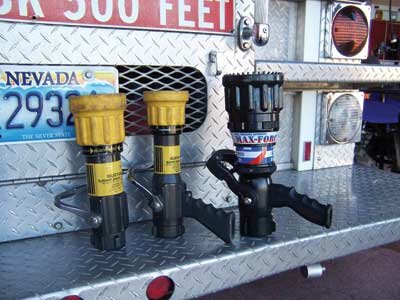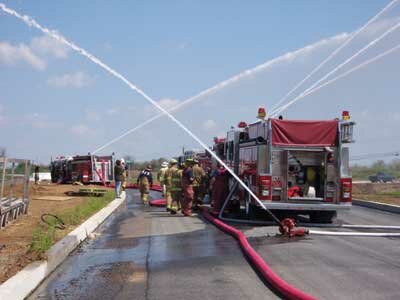Automatic NozzlesComment on this page
Original article → The Automatic Nozzle: Another Tool in the Toolbox
By Author(s): Paul Shapiro
Published October 10, 2014 | From Volume 19, Issue 10 of Fire Apparatus Magazine
History
The automatic nozzle was invented by Clyde McMillan, founder of Task Force Tips, who was the chief of the Gary (IN) Fire Task Force. This was a volunteer fire company formed to assist the municipal fire department in Gary, Indiana, on large structure fires. For the most part, the Gary Fire Task Force was a big water company that mainly provided master stream operations. Large-volume-water-delivery fires can have water supply issues that can negatively impact fire stream quality. There were two basic types of master stream nozzles used in those days: a smooth bore nozzle and a combination nozzle. Both of these nozzles are considered fixed-gallonage because they require a specific nozzle pressure (NP) to produce the nozzle’s rated flow [gallons per minute (gpm)]. This in itself can be difficult to achieve at large-flow fires with hydrant system pressures dropping as flow demands increase. McMillan was well aware of this problem and decided to come up with a solution that would provide a quality stream, as far as reach is concerned, even with an uncertain water supply. Thus, the automatic nozzle was born.
How It Works
The main component of an automatic nozzle is designed around a pressure control unit that is calibrated to the nozzle’s required NP, thus maintaining a near constant pressure throughout the nozzle’s flow range. The reason why it’s called a near constant pressure is because there is a slight difference in the NP from the bottom of a nozzle’s flow range to the top. National Fire Protection Association (NFPA) 1962, Standard for the Care, Use, Inspection, Service Testing, and Replacement of Fire Hose, Couplings, Nozzles, and Fire Hose Appliances, states that an automatic nozzle can have a NP range of plus or minus 15 pounds per square inch (psi) within its flow range.
These nozzles are all automatic nozzles. Two (left and center) are manufactured by Elkhart Brass; the third (right) is a Task Force Tips (TFT) nozzle. (Photos by Paul Shapiro)
Here is a more simple way to explain this function using a garden hose. A garden hose without a nozzle connected to it is simply an open-butt hose. This is good for just filling things up. However, to get any reach with a garden hose stream, you put your thumb over the opening of the hose, creating back pressure, which creates a decent stream for your task at hand. Think about how you would use your thumb to maintain a far enough stream to reach 15 feet away to a flowerpot. You would have to depress your thumb into the stream to create more reach and then possibly retract your thumb if the stream was going beyond the target. This is exactly the way an automatic nozzle works, except it doesn’t require any thinking from the operator. It works automatically based on its design.
These two charts show flows for two types of fixed-gallonage nozzles: a combination nozzle and a smooth bore nozzle. They show how a drop in NP reduces the flow. What the charts don’t show is that when the NP decreases, so does the stream’s reach.
Theory
It’s important to understand that the automatic nozzle concept is based totally on maintaining a near constant NP, thus producing the best possible stream. Everything else about delivering water through a handline or master stream with an automatic nozzle is no different than delivering water to a fixed-gallonage nozzle. You still have to have enough water to support the required gpm. You still have to calculate friction loss for the required flow in the hose and appliance. The big difference with the automatic nozzle is that, as long as the flow rate is within the flow range of the nozzle, it will maintain, for the most part, the stream reach quality even without the required gpm. With a fixed-gallonage nozzle, the stream reach will drop if the pump operator cannot meet the required pressure for the nozzle, whether the drop is from the wrong size tip, a depleted water supply, or just an incorrect engine pressure.
If personnel can't obtain the rated gpm for a fixed-gallonage nozzle for whatever reason, the NP will be below its rating and stream's reach will be diminished.
If firefighters can’t produce the nozzle’s rated flow when using smooth bore tips, they can reduce the tip size to improve stream quality. However, this takes time and a little bit of guesswork to make it work. With the automatic nozzle there is no delay or guesswork. It adjusts to the flow the pump operator delivers to it.
One problem with a fixed-gallonage combination nozzle is that there are no other choices to switch to. Basically you have to live with the stream it is producing if you cannot increase the gpm to the nozzle’s rated flow.
Application
Automatic nozzles have two applications: handlines and master streams. The flow ranges for small-handline nozzles vary from 90 to 200 gpm depending on the model. NPs for small handlines can vary from 55 to 100 psi, again based on the model. They are usually found on 1¾-inch interior attack lines but can be used on booster, 1½-, and two-inch lines. The 2½-inch handlines have flow ranges from 250 all the way up to 500 gpm and also have NPs ranging from 55 to 100 psi. For municipal applications, master stream nozzles can vary from 500 to 2,000 gpm, with nozzle pressures ranging from 75 to 120 psi, based on the model.
Unlike smooth bore nozzles, automatic nozzles have internal components that could cause debris to interfere with stream quality. An automatic nozzle has a flushing mechanism built into it for flushing debris. Firefighters can flush an automatic nozzle by turning the nozzle all the way to full fog and going just a little further until the rotation stops. This puts the nozzle in the flush mode. It’s important to gate the nozzle down before getting out of flush mode because nozzle reaction could create an unsafe situation.
Manufacturers have specific instructions for field maintenance for automatic nozzles, which includes specific lubrication.
True or False
As I mentioned, firefighters are passionate about the nozzles they use. There have been many pro and con comparisons with automatic and fixed-gallonage nozzles. The following includes some of these pros and cons and analyses of them.
The automatic nozzle can be unsafe because it will always give you the appearance of a good stream but may be misleading if it is lacking the required gpm.
If all you are relying on is stream appearance to determine whether your handline is flowing the required gpm, this would be true. The bottom line is that a firefighter should have a good idea of what the nozzle reaction feels like for the line he is using and should be able to determine, to a degree, if the stream is underpumped. Taking this one step further, how far does a stream have to reach during an interior attack? The fact is that any nozzle, not just automatics, can have an underpumped stream. Yet, the stream will appear to be good in the confined spaces of an interior attack. In fact, there is a good chance you won’t be able to see the entire stream because of the smoke and fire itself.
A smooth bore nozzle has a harder-hitting stream than an automatic nozzle.
The automatic nozzle fixes the fire stream performance problem by adjusting to the available gpm within its flow range while keeping a near constant NP.
This is another myth. The truth is that the highest NP will have the highest or hardest impact. Many flow tests have proven this.
Here’s a simple flow test you can try to prove this point. It involves placing an automatic nozzle and a smooth bore nozzle side by side pointing straight up in the air connected to portable monitors. The smooth bore nozzle will have an 1 1⁄8-inch tip and be pumped at an NP of 50 psi to get a 265-gpm flow. The automatic nozzle is pumped at a 100-psi NP and also flows 265 gpm. To make this test accurate, use a flowmeter for the automatic nozzle and a handheld pitot gauge to measure the NP for the smooth bore. The streams should look identical; however, the automatic nozzle’s stream will go approximately 10 feet higher than the smooth bore. Earth’s gravity functions as resistance for this test.
The automatic nozzle is a cure-all for a poor water supply.
This is absolutely false. Automatic nozzles cannot create water. Water has to come from the water supply. The automatic nozzle can create a decent stream caused by a low water supply; however, it’s important to understand that a stream with decent reach does not mean it has the required gpm.
The automatic nozzle is a tool that will allow you get the best reach out of your stream in a poor water supply situation. However, an automatic nozzle is not the fix for a poor water supply. The only fix for a poor water supply is to go out and find more water.
About the Author
PAUL SHAPIRO is director of Fire Flow Technology. He is a nationally recognized instructor on large-flow water delivery. He is also a retired engineer from the Las Vegas (NV) Fire Department. He has authored numerous articles for fire trade magazines. He has been in the fire service since 1981, is author of Layin’ the Big Lines, and produced the first in a series of videos on large-flow water delivery.




 Last edited 2015-11-05 19:19 UTC by
Last edited 2015-11-05 19:19 UTC by ![[Twitter]](/img/twitter_box.png)
![[RSS]](/img/rss_box.png)